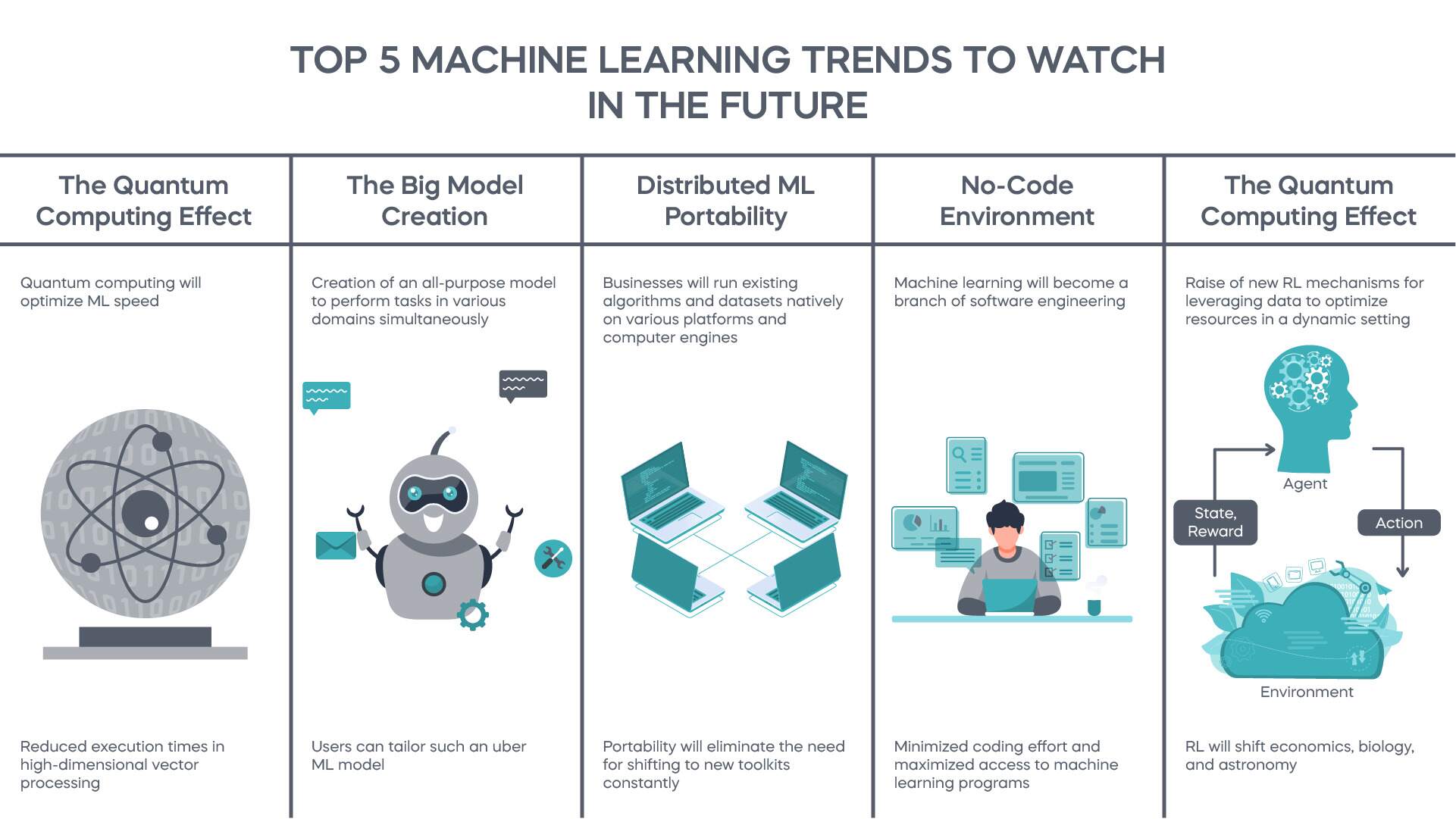Introduction
Machine learning, also known as artificial intelligence, has become increasingly popular and influential in today’s rapidly evolving technological landscape. From recommendation systems to self-driving cars, machine learning has revolutionized various industries and will continue to shape the future. Harnessing the power of data, machine learning algorithms can analyze patterns, make predictions, and adapt through experience without being explicitly programmed. This groundbreaking technology has the potential to transform the way we live, work, and interact.
Machine learning is a subset of artificial intelligence focused on developing algorithms that enable computers to learn and make data-driven decisions or predictions without being explicitly programmed. The learning process involves training the algorithms on large datasets to recognize patterns, understand relationships, and make accurate predictions or classifications. The algorithms continuously improve their performance as they are exposed to more data and feedback.
The power of machine learning lies in its ability to handle large and complex datasets. It can process, analyze, and draw valuable insights from vast amounts of data quickly and accurately, which would be nearly impossible for humans to achieve manually. By automating decision-making processes, machine learning can save time, reduce costs, and increase efficiency in various industries.
Machine learning has made significant advancements and impacts across a wide range of industries. In healthcare, it is being used to improve disease diagnosis, predict treatment outcomes, and personalize patient care. In finance, machine learning algorithms analyze market trends, detect fraudulent activities, and optimize investment strategies. In manufacturing, they optimize production processes, predict equipment failures, and enhance supply chain management. These are just a few examples of how machine learning is transforming industries and driving innovation.
The applications of machine learning are vast and continually expanding. From natural language processing and image recognition to recommendation systems and autonomous vehicles, machine learning is revolutionizing the way we interact with technology. Natural language processing enables machines to understand and generate human language, leading to advancements in virtual assistants and chatbots. Image recognition algorithms can accurately identify and classify objects in images, enabling applications in fields like autonomous driving and medical imaging analysis. Recommendation systems leverage machine learning to provide personalized recommendations based on user preferences and behaviors, improving customer experience and increasing sales.
In today’s job market, possessing machine learning skills is becoming increasingly valuable and in-demand. As more industries adopt machine learning technologies, the demand for professionals with expertise in this field continues to grow. Companies are looking for data scientists, machine learning engineers, and analysts who can develop, deploy, and optimize machine learning models. Having a solid understanding of machine learning concepts, algorithms, and programming languages such as Python and R can give individuals a competitive edge in the job market.
While machine learning presents immense opportunities, it also has its share of challenges and limitations. Privacy and security concerns arise when dealing with sensitive data, as machine learning models require access to large amounts of data for training. Ethical considerations surrounding algorithms and biases need to be addressed to ensure fairness and transparency in decision-making processes. Additionally, there may be limitations in accuracy and generalization when working with complex and dynamic datasets, requiring ongoing model refinement and improvements.
Looking ahead, the future of machine learning holds great promise. As technology continues to advance, machine learning algorithms will become more sophisticated, enabling even more complex and accurate predictions. The integration of machine learning with other emerging technologies such as augmented reality and blockchain has the potential to create groundbreaking applications and solutions. With the increasing availability of data and computing power, machine learning will continue to shape the way we live, work, and innovate.
What is Machine Learning?
Machine learning is a subset of artificial intelligence that focuses on the development of algorithms that enable computers to learn and make data-driven decisions or predictions without being explicitly programmed. The goal of machine learning is to allow computers to learn from data and experience, identify patterns, and make accurate predictions or classifications.
Unlike traditional programming, where explicit instructions are given to a computer to perform specific tasks, machine learning algorithms can learn and improve on their own. Instead of being programmed with explicit rules, machine learning models are trained on large amounts of data and exposed to different scenarios. Through this learning process, they are able to recognize patterns and relationships, and use that knowledge to make predictions or take actions.
The machine learning process typically involves several steps. First, a dataset is collected, which consists of input variables (also known as features) and their corresponding output variables or labels. The dataset is then divided into a training set and a testing set. The training set is used to train the machine learning model, while the testing set is used to evaluate its performance.
During the training phase, the machine learning algorithm analyzes the features and labels in the training set to identify patterns and relationships. It adjusts the model’s parameters based on the observed data and tries to minimize the discrepancy between the predicted outputs and the actual outputs. This process is known as model training or learning.
Once the model is trained, it can be used to make predictions or classifications on new, unseen data. This is known as the inference phase. The machine learning model takes the input variables from the new data and produces the corresponding output variables. The accuracy and effectiveness of the model’s predictions are measured by comparing them to the actual outputs from the testing set.
There are different types of machine learning algorithms, each with its own strengths and weaknesses. Supervised learning algorithms learn from labeled data, where the desired output is known. They are used for prediction and classification tasks. Unsupervised learning algorithms, on the other hand, learn from unlabeled data and identify patterns and relationships without any specific target variable. They are used for clustering and dimensionality reduction tasks. Semi-supervised learning combines elements of both supervised and unsupervised learning, leveraging a small amount of labeled data and a larger amount of unlabeled data.
Reinforcement learning is another type of machine learning where an agent learns how to interact with an environment to maximize a reward signal. It uses a trial-and-error approach to learn optimal actions in different situations. Reinforcement learning is often used in robotics, gaming, and control systems.
In summary, machine learning is a powerful technology that enables computers to learn from data and make predictions or classifications without being explicitly programmed. By identifying patterns and relationships in large datasets, machine learning algorithms can automate decision-making processes, save time, and improve accuracy in various domains.
The Power of Machine Learning
Machine learning has the potential to revolutionize the way we live and work by leveraging the power of data and algorithms. It provides businesses, organizations, and individuals with the ability to make accurate predictions, automate processes, and gain valuable insights that were previously unimaginable. The power of machine learning lies in its ability to handle large and complex datasets, learn from experience, and continuously improve its performance.
One of the key strengths of machine learning is its ability to process and analyze massive amounts of data quickly and accurately. Traditional data processing methods would often fall short when faced with the scale and complexity of big data. Machine learning algorithms, however, excel in dealing with this challenge. By leveraging advanced algorithms and parallel computing, machine learning systems can extract meaningful patterns and insights from vast volumes of data, enabling organizations to make data-driven decisions with confidence.
Machine learning algorithms also have the remarkable capability to learn from experience and adapt. Traditional programming relies on explicit instructions, but machine learning removes the need for explicit programming by enabling algorithms to learn and improve on their own. Through exposure to data and feedback, machine learning models can continuously refine their performance, enhance accuracy, and become more efficient over time. This adaptability is especially valuable in dynamic and complex environments where traditional rule-based systems may struggle to keep up.
Machine learning has demonstrated impressive performance in a wide range of applications. For example, in healthcare, machine learning is being used to improve disease diagnosis and treatment planning. By analyzing medical records, genomic data, and patient symptoms, machine learning models can make accurate predictions for disease identification and recommend personalized treatment options. This not only saves time and resources but also improves patient outcomes and quality of care.
Another area where machine learning shines is in recommendation systems. Companies like Netflix, Amazon, and Spotify leverage machine learning algorithms to analyze user preferences and behaviors in order to provide personalized recommendations. These algorithms can predict user preferences, identify patterns, and suggest content that the user is likely to enjoy. This personalized approach enhances customer experience, boosts engagement, and increases sales.
Furthermore, machine learning plays a crucial role in optimizing business processes and operations. In finance, machine learning algorithms are used for fraud detection, risk assessment, and trading strategies. By analyzing vast amounts of historical financial data, machine learning models can identify patterns and anomalies that indicate fraudulent activities. This helps financial institutions prevent fraudulent transactions and protect their customers’ assets. In manufacturing, machine learning algorithms can optimize production processes, detect equipment failures in advance, and analyze supply chain patterns to reduce costs and increase efficiency.
As machine learning capabilities evolve, the potential applications and benefits continue to expand. From autonomous vehicles and chatbots to natural language processing and image recognition, machine learning is transforming industries and reshaping the way we interact with technology. It enables machines to understand human language, recognize objects, and make decisions based on complex scenarios. The power of machine learning lies in its ability to automate tasks, generate insights, and make accurate predictions, ultimately driving innovation and pushing the boundaries of what is possible.
Machine Learning in Various Industries
Machine learning is revolutionizing a wide range of industries, enabling businesses to gain valuable insights, automate processes, and make data-driven decisions. From healthcare to finance to manufacturing, machine learning is transforming the way organizations operate and driving innovation. Let’s explore how machine learning is being applied in various industries.
In healthcare, machine learning is being used to improve disease diagnosis, predict treatment outcomes, and personalize patient care. By analyzing medical records, genetic data, and patient symptoms, machine learning models can identify patterns and make accurate predictions for disease identification. This enables healthcare professionals to make quicker and more informed decisions, leading to better patient outcomes. Machine learning also plays a crucial role in drug discovery and development, helping researchers identify potential candidates and predict their effectiveness.
In the financial industry, machine learning is utilized for fraud detection, risk assessment, and algorithmic trading. Machine learning algorithms can analyze large volumes of financial data to detect patterns and anomalies that indicate fraudulent activities. This helps financial institutions prevent financial losses and protect their customers’ assets. In addition, machine learning models can analyze market trends and historical data to predict stock prices and optimize trading strategies, enhancing investment decisions.
Machine learning has brought significant advancements to the manufacturing industry as well. By leveraging machine learning algorithms, manufacturers can optimize production processes, predict equipment failures, and enhance supply chain management. Predictive maintenance, powered by machine learning, can identify equipment abnormalities and schedule maintenance before breakdowns occur, minimizing downtime and maximizing productivity. By analyzing supply chain patterns, machine learning algorithms can identify areas for improvement, optimize inventory management, and reduce costs.
The retail industry has also seen the impact of machine learning. Recommendation systems, powered by machine learning algorithms, are used by e-commerce giants like Amazon and Netflix to provide personalized recommendations to customers. These algorithms analyze user behavior, purchase history, and preferences to deliver relevant and targeted suggestions, increasing customer engagement and conversion rates. Additionally, machine learning models can analyze customer sentiment and social media data to identify trends and improve marketing strategies.
In transportation and logistics, machine learning is being applied to optimize routes, improve traffic flow, and enhance vehicle safety. Machine learning algorithms can analyze a variety of data sources, such as historical traffic patterns, weather conditions, and real-time sensors, to predict optimal routes and reduce travel time. Furthermore, machine learning models are used in the development of autonomous vehicles, enabling them to navigate and make decisions based on real-time data and complex scenarios.
Machine learning also has applications in areas such as energy, agriculture, and cybersecurity. In the energy sector, machine learning algorithms can analyze energy usage patterns and optimize energy distribution, reducing costs and enhancing efficiency. In agriculture, machine learning models can predict crop yields, optimize irrigation schedules, and detect diseases in plants. In cybersecurity, machine learning helps identify and respond to cyber threats in real-time, detecting patterns and anomalies that indicate potential attacks.
Overall, machine learning is transforming various industries, empowering businesses to make data-driven decisions, automate processes, and gain a competitive edge. As the technology continues to advance, the potential applications of machine learning in different sectors are expanding, opening up new opportunities and driving further innovation.
Top Applications of Machine Learning
Machine learning has found its way into numerous applications across various industries and domains. Its ability to analyze vast amounts of data, identify patterns, and make accurate predictions has paved the way for groundbreaking advancements and innovations. Let’s explore some of the top applications of machine learning that are transforming the way we live, work, and interact with technology.
One of the most prominent applications of machine learning is in the field of healthcare. Machine learning algorithms are being used to improve disease diagnosis, forecast treatment outcomes, and personalize patient care. By analyzing medical records, genetic data, and clinical symptoms, machine learning models can identify patterns and make accurate predictions for disease identification. This enables healthcare professionals to make more precise and informed decisions, ultimately improving patient outcomes and quality of care. Machine learning also plays a vital role in drug discovery, helping researchers identify potential candidates and predict their effectiveness.
Another notable application of machine learning is in the field of finance. Machine learning algorithms are used for fraud detection, risk assessment, and algorithmic trading. These algorithms can analyze large volumes of financial data, such as transaction records, market trends, and customer behavior, to detect patterns and anomalies that indicate fraudulent activities. This helps financial institutions prevent financial losses and protect their customers’ assets. Machine learning models also play a crucial role in predicting market trends and optimizing trading strategies, improving investment decisions and outcomes.
Machine learning has revolutionized the retail industry through recommendation systems. Companies like Amazon and Netflix leverage machine learning algorithms to analyze customer preferences, purchase history, and behavior to provide personalized recommendations. These algorithms use data-driven insights to suggest relevant and targeted products or content, enhancing customer experience and increasing sales. Additionally, machine learning models can analyze customer sentiment and social media data to identify trends, improve marketing strategies, and personalize customer interactions.
Transportation and logistics have also seen significant advancements through machine learning applications. Machine learning algorithms optimize routes, improve traffic flow, and enhance vehicle safety. By analyzing historical traffic patterns, weather conditions, and real-time sensor data, machine learning models can predict optimal routes and reduce travel time. Machine learning also plays a key role in the development of autonomous vehicles, enabling them to navigate and make decisions based on real-time data and complex scenarios.
The power of machine learning is evident in the field of natural language processing (NLP), where algorithms can understand and generate human language. This has led to advancements in virtual assistants, chatbots, and language translation. Machine learning models can analyze vast amounts of text data, understand context, and generate human-like responses, providing seamless interactions and efficient customer support. Language translation applications that utilize machine learning algorithms can accurately translate between different languages, breaking down communication barriers and enabling global connectivity.
Machine learning also has applications in areas such as image recognition, cybersecurity, and manufacturing. Image recognition algorithms can accurately identify and classify objects in images, enabling applications in fields like autonomous driving and medical imaging analysis. In cybersecurity, machine learning models analyze data and detect patterns to identify and respond to cyber threats in real-time. In manufacturing, machine learning algorithms optimize production processes, predict equipment failures, and enhance supply chain management, improving efficiency and reducing costs.
These are just a few examples of the top applications of machine learning that are transforming various industries. As technology continues to advance, the potential for machine learning to revolutionize even more sectors and create innovative solutions is limitless.
The Importance of Machine Learning Skills
In today’s data-driven world, possessing machine learning skills is becoming increasingly essential for professionals in a wide range of industries. As machine learning continues to shape the future of technology and innovation, individuals with expertise in this field are in high demand. Let’s explore the importance of machine learning skills in the current job market and how they can give individuals a competitive edge.
Machine learning skills are valuable for several reasons. Firstly, machine learning has become a key driver of business success. Organizations are leveraging machine learning algorithms to gain insights from data, automate processes, and make data-driven decisions. Professionals with machine learning skills can help businesses harness the power of data, optimize operations, and drive innovation. Machine learning skills are particularly relevant in industries such as healthcare, finance, retail, transportation, and manufacturing, where data-driven decision-making and process automation are critical for success.
Secondly, machine learning skills are in high demand due to the shortage of qualified professionals in the field. As machine learning adoption grows, the demand for skilled individuals who can develop, deploy, and optimize machine learning models is surpassing the available talent pool. This skill gap presents an excellent opportunity for individuals to enter the job market with a competitive advantage. Having machine learning skills allows professionals to stand out and opens up a wide range of career opportunities.
Professionals with machine learning skills are not only sought after by tech companies but also by companies in various industries that are adopting machine learning technologies. These individuals can contribute to improved decision-making, enhanced productivity, and better customer experiences. They can also drive innovation within their organizations by identifying new ways to solve problems and create value through machine learning applications.
Machine learning skills are also critical for data scientists and analysts. As more organizations generate vast amounts of data, there is a growing need for professionals who can extract valuable insights from this data. Machine learning techniques and algorithms play a crucial role in analyzing large datasets, identifying patterns, and making predictions. Proficiency in machine learning allows data scientists and analysts to uncover hidden patterns, identify trends, and develop accurate predictive models that can inform business strategies and decision-making processes.
Furthermore, machine learning skills enable professionals to keep up with the evolving landscape of technology. As machine learning continues to advance, new algorithms, tools, and techniques emerge. Having a strong foundation in machine learning allows individuals to stay updated with the latest developments and adapt to the changing demands of the industry. This adaptability is essential in an industry where technology evolves rapidly.
In summary, machine learning skills are highly valuable in today’s job market. They provide professionals with the ability to contribute to data-driven decision-making, automate processes, and drive innovation. The demand for individuals with machine learning skills is rapidly increasing, and possessing these skills can give individuals a competitive edge in their careers. Whether in technology companies or in industries that are adopting machine learning, professionals with machine learning skills are well-positioned for success.
Challenges and Limitations of Machine Learning
While machine learning has brought significant advancements and opportunities, it also comes with its fair share of challenges and limitations. Understanding and addressing these challenges is crucial to harnessing the full potential of machine learning and ensuring its responsible and effective use. Let’s explore some of the key challenges and limitations of machine learning.
One of the primary challenges is the need for high-quality and diverse training data. Machine learning models rely on vast amounts of data to learn and make accurate predictions. However, if the training data is biased, incomplete, or unrepresentative, it can lead to biased or inaccurate results. Ensuring the quality, diversity, and reliability of training data is essential to avoid biased decision-making and to build robust and fair machine learning models.
Another challenge is the issue of interpretability. Machine learning models can be highly complex, making it difficult to understand how they arrive at their predictions or decisions. This lack of interpretability can be a hurdle in fields where transparency, accountability, and explainability are important, such as healthcare and finance. Efforts are being made to develop interpretable machine learning techniques, enabling users to understand the reasoning behind the model’s predictions and make informed decisions.
Privacy and security are also significant concerns when it comes to machine learning. Training machine learning models often require access to sensitive and personal data, which raises questions about data privacy and ethical considerations. Safeguarding data privacy, ensuring data anonymity, and implementing robust security measures are essential to protect individuals’ information and maintain trust in machine learning systems.
Machine learning models are designed based on historical data, and they assume that the future will be similar to the past. However, this assumption may not always hold true, particularly in rapidly changing or evolving environments. Machine learning models may struggle to adapt to new situations or handle unseen scenarios. Ongoing monitoring, updating, and retraining of models are necessary to ensure their performance remains accurate and effective.
Another limitation is the dependency on high computing power and resources. Training complex machine learning models can require significant computational resources, including processing power and storage capacity. Access to these resources can be a limitation for smaller organizations or individuals with limited resources. Cloud-based services and advancements in hardware technology are helping to address this challenge, making machine learning more accessible to a broader range of users.
Furthermore, the ethical implications of machine learning algorithms deserve careful consideration. Machine learning models can inherit biases from the training data, perpetuating and amplifying existing societal biases. Mitigating bias, ensuring fairness, and addressing ethical considerations are crucial to prevent discrimination and to ensure that machine learning systems contribute positively to society.
In summary, machine learning brings forth several challenges and limitations that need to be carefully addressed. The quality of training data, interpretability of models, privacy and security concerns, adaptability to changing environments, resource requirements, and ethical considerations are all important factors to consider. By addressing these challenges head-on and developing responsible practices, we can overcome limitations and maximize the potential of machine learning for positive and impactful outcomes.
The Future of Machine Learning
Machine learning has already made significant advancements and transformed various industries, but its future holds even greater promise. As technology continues to evolve at a rapid pace, machine learning is expected to play an increasingly central role in shaping our lives, revolutionizing industries, and driving innovation. Let’s explore some key areas where machine learning is expected to make significant progress in the future.
One area of focus for the future of machine learning is in improving the interpretability and explainability of models. Researchers and developers are working to develop new techniques to enhance the transparency of machine learning algorithms, allowing users to understand how decisions are being made. Explainable AI will become increasingly important, particularly in fields where accountability, fairness, and ethical considerations are paramount.
The integration of machine learning with other emerging technologies is another exciting prospect for the future. Machine learning algorithms combined with augmented reality (AR) and virtual reality (VR) can lead to revolutionary applications in areas such as gaming, training, and immersive experiences. Similarly, combining machine learning with blockchain can enhance security, privacy, and trust in machine learning systems, opening up new possibilities in areas like healthcare, finance, and supply chain management.
Advancements in natural language processing (NLP) and language translation will continue to make machine learning models more conversational and human-like. Chatbots and virtual assistants powered by machine learning algorithms will become even more sophisticated and capable of understanding complex queries, generating natural language responses, and providing personalized assistance. This has extensive implications for customer support, communication, and user experience.
Continued progress in computer vision and image recognition will enable machines to understand visual content with greater accuracy. This will lead to advancements in areas such as autonomous driving, medical imaging analysis, and object recognition. Machine learning models will be able to recognize and interpret objects, scenes, and gestures, opening up new opportunities for automation, safety, and decision-making in various domains.
Another area of growth for machine learning is in reinforcement learning, where machines learn to make decisions and take actions through trial-and-error interactions with an environment. Reinforcement learning has shown promise in areas like robotics and game playing, and it is expected to continue evolving and finding applications in diverse fields, including autonomous systems, healthcare, and finance.
To support these advancements, the availability and accessibility of data and computing power will play a crucial role. The increasing amount of data generated and the advancements in cloud computing and edge computing will provide the foundation for more robust and scalable machine learning systems. Additionally, improvements in hardware, such as quantum computing and specialized chips for machine learning, will further accelerate the development and deployment of machine learning models.
Ethical considerations will also be at the forefront as machine learning progresses. The responsible development and use of machine learning will require addressing issues of bias, discrimination, fairness, and transparency. Efforts to develop ethical guidelines, standards, and regulations will help shape the future of machine learning and ensure that it is used in a way that benefits society as a whole.
In summary, the future of machine learning is full of potential. As the technology continues to advance, we can expect improvements in interpretability, integration with other emerging technologies, advancements in NLP and computer vision, growth in reinforcement learning applications, and advancements in data availability and computing power. Ensuring the responsible and ethical use of machine learning will be crucial as we move forward, to maximize the positive impact of this powerful technology on our lives and the world around us.
Conclusion
Machine learning has emerged as a transformative technology that has the power to revolutionize industries, drive innovation, and unlock new possibilities. Its ability to analyze vast amounts of data, extract valuable insights, and make accurate predictions has already made a significant impact in various sectors such as healthcare, finance, retail, transportation, and manufacturing. The demand for professionals with machine learning skills is rapidly increasing, as organizations recognize the value of leveraging data to make informed decisions and stay competitive in a data-driven world.
However, machine learning also presents challenges and limitations that need to be addressed. Ensuring the quality and diversity of training data, interpretability of models, privacy and security, adaptability to new environments, resource requirements, and ethical considerations are crucial for responsible and effective use of machine learning. Addressing these challenges will be essential in realizing the full potential of machine learning and ensuring that it remains a force for positive change.
Looking ahead, the future of machine learning is filled with promise. Advancements in interpretability, integration with emerging technologies, natural language processing, computer vision, reinforcement learning, and accessible computing infrastructure will further propel the growth of machine learning. The responsible and ethical use of machine learning will be of utmost importance, guiding the development and implementation of policies, guidelines, and standards to ensure fairness, accountability, and transparency.
As we embrace the future of machine learning, it is crucial to continue fostering collaboration, innovation, and learning in this field. Professionals who possess machine learning skills are well-positioned for success in the job market, and organizations that embrace and invest in machine learning will stay ahead of the curve in their respective industries.
Machine learning has the potential to transform the way we live and work, making processes more efficient, predictions more accurate, and decision-making more informed. By harnessing the power of data, algorithms, and human expertise, we can leverage machine learning to create a future that is smarter, more connected, and more impactful.

























